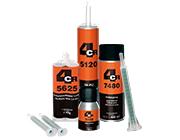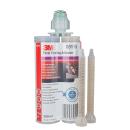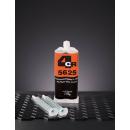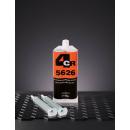Two-component bodywork adhesive

Two-component bodywork adhesive for cars
-
 081152K Epoxy Glue 200mlBody panels
081152K Epoxy Glue 200mlBody panels -
 5625.00502K PU PVC adhesive50ml - 1.5 minutes
5625.00502K PU PVC adhesive50ml - 1.5 minutes -
 5626.00502K PU PVC adhesive50ml - 3.5 minutes
5626.00502K PU PVC adhesive50ml - 3.5 minutes
︾
Two-component bodywork adhesives for your car or motorbike repairs:
Two-component adhesives, also known as two-component or two-component adhesives, offer a number of significant advantages in the field of car bodywork. These adhesives are made up of two separate parts (resin and Hardener) which need to be mixed before application. Here are some of the key benefits of two-component bodywork adhesives:
1. High structural strength:
Two-component adhesives generally offer high structural strength, making them ideal for applications where a strong, durable bond is essential. They are often used in bodywork repair projects where mechanical strength is crucial.
2. Adaptability to different materials:
These adhesives are formulated to adhere to a variety of materials, including metal, plastic, rubber and even some hard-to-bond surfaces. This makes them versatile for different bodywork applications.
3. Flexible working time:
Two-component adhesives often offer flexibility in terms of working time. Curing usually begins after the components have been mixed, allowing bodywork professionals to position and adjust parts before the adhesive fully cures.
4. Fast, effective adhesion :
Once mixed and applied, the adhesive components react quickly to provide an effective bond. This can be particularly advantageous in situations where rapid bonding is required.
5. Versatile applications :
Two-component adhesives are versatile and can be used in a variety of bodywork applications, such as bonding body panels, fixing interior components, repairing plastic parts, and even for projects requiring structural bonding.
6. Durability in demanding conditions:
These adhesives are often formulated to withstand demanding conditions such as vibration, temperature variations, exposure to weather and UV. This ensures the durability of repairs in a variety of automotive environments.
7. Reduced visible fixing points:
The use of two-component adhesives can sometimes reduce the need for visible fixing points, such as rivets or welds. This can contribute to more aesthetically pleasing finishes and simplify the repair process.
8. Sanding and finishing options :
Once fully cured, two-component adhesives can often be sanded and finished to achieve a smooth, even surface. This allows aesthetic results to be achieved after the repair.
In summary, two-component adhesives are advanced and versatile solutions for car bodywork, offering strong adhesion, high structural strength and the ability to adapt to a variety of materials and conditions. They are widely used for precise and durable repairs.
Your questions on the use of two-component car body adhesives :
1. Why should I choose two-component adhesives rather than other types of bodywork adhesive?
Two-component adhesives offer high structural strength and versatility of application. They are ideal for repairs requiring strong adhesion to different bodywork materials such as metal and plastic.
2. How does the process of mixing the components in a two-component adhesive work?
Two-component adhesives generally involve mixing a resin and a Hardener in specific proportions. Follow the manufacturer's instructions to ensure a homogeneous mix, which is essential for optimum adhesive performance.
3. Can two-component adhesives be used for temporary repairs or are they primarily intended for permanent applications?
Two-component adhesives are often used for permanent repairs because of their high structural strength. However, some products also offer temporary options, depending on the specific need of the project.
4. What types of bodywork surfaces are compatible with two-component adhesives?
Two-component adhesives are versatile and compatible with a variety of body materials such as metal, plastic and rubber. Check the product specification to ensure compatibility with the specific material you plan to bond.
5. What is the optimum working time for two-component adhesives and how does this affect the repair process?
Working time, or open time, varies from one product to another. It represents the period during which the adhesive can be applied and the parts adjusted before curing. Following the manufacturer's instructions is crucial to optimising the efficiency of the repair process.
6. Is it necessary to prepare the surface before applying the two-component adhesive, and if so, what steps are recommended?
Yes, surface preparation is essential. Make sure the area to be bonded is clean, dry and free of contaminants. In some cases, lightly abrading the surface can improve adhesion. Follow the manufacturer's recommendations for best results.
7. Can surfaces bonded with two-component adhesives be painted or finished?
Yes, once cured, some two-component adhesives can be sanded, painted and finished to give a smooth, attractive surface. Check product specifications to ensure compatibility with finishing procedures.
8. Are there any specific recommendations for storing two-component adhesives?
Yes, storing the individual components in appropriate conditions is essential to prolong their life. Follow the manufacturer's instructions regarding storage temperature and shelf life.
These questions and answers are intended to provide useful information on the use of two-component adhesives in car bodywork, helping users to make informed decisions when carrying out repair projects.